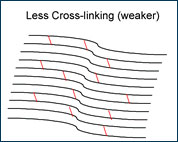The indications for cross-linking today are corneal ectasia disorders such as keratoconus and pellucid marginal degeneration, iatrogenic keratectasia after refractive lamellar surgery, and corneal melting that is not responding to conventional therapy.
The HistoryThe procedure was developed from 1993 till 1997 by Prof. Theo Seiler and Prof. Eberhard Spoerl at the University of Dresden, Germany. First patients were treated in 1998. Today corneal cross-linking is performed in many places around the world. Many eyes have been cross-linked world wide in controlled clinical studies with a follow up of up to 5 years.
Clinical studies have shown a significant increase in best corrected visual acuity (BCVA) in many of the treated eyes. Six months after corneal cross-linking the refractive cylinder was reduced in most of the eyes. The steepest K-value was usually decreased by 1 diopter and the percentage of eyes that had a clinical relevant reduction is very high.
Safety
Corneal cross linking is considered to be a safe procedure, provided the recommended safeguards are observed.
Minimum corneal thickness has to be 400 µ after removal of the epithelium. This is intended to protect the corneal endothelium from UV-A radiation. A 400 µ cornea soaked with riboflavin absorbs about 95% of the total radiation so that only a small amount reaches the endothelium.
Up until today no sight threatening side effects have been reported.
Keratoconus is a disease with an uncertain cause, and its progression following diagnosis is unpredictable. If afflicting both eyes, the deterioration and further progression of the disease may lead to a need for cornea transplant. It is estimated that eventually 21% of the keratoconus patients require surgical intervention to restore corneal anatomy and eyesight.
Corneal cross linking has been shown to slow or arrest the progression of keratoconus, and in some cases even reversed it. This procedure has the potential to become the standard treatment for keratoconus thus preventing the need for penetrating keratoplasty!
In conclusion, early treatment with this procedure will enormously reduce the need for future corneal transplantation for many of the keratoconus patients. It will be a great relief to our current shortage of available corneal tissues for transplantation.



